To explore aquatic biodiversity, Mahatma Gandhi Marine National Park located near Wandoor, 29 km west of Port Blair in the South Andaman district of the Andaman and Nicobar Islands in India is a perfect place famous for its rich and varied aquatic habitats. It is a part of the Andaman archipelago and one of the oldest and most important places spread over a total area of 281.5 sq. km, consisting of 15 green and vegetated islands within the Labyrinth group.
Out of the total 281.5 sq. km area of the park, only about 61.5 sq. km is landmass, which includes 10 large and medium-sized islands, 5 small islands, and around 600 hectares of coastal strip above the high tide line. The remaining 220.5 sq. km consists of open sea and creeks.
Geographically, Mahatma Gandhi Marine National Park is situated between the northwest coast of Rutland Island and the southwest coast of South Andaman Island at coordinates 11°32′22″N 92°35′02″E.
The park was declared a national park on May 24, 1983, under the Wildlife Protection Act of 1972 to protect and preserve its rich biodiversity of aquatic life, including mangroves, coral reefs, sea turtles, and other marine ecosystems.
Jollybouy, Redskin, Grub, and Chester are some of the major islands rich in coral diversity in this park. The Department of Environment and Forests, A & N Islands Administration, Port Blair, is the management authority of the park.
- Year of declaration: 1983
- Area: 281.5 km2
- Number of isIands:15
- Land Area:61.0 km2
- Territorial water: 220.5 km2
- Islands open for tourists: Jolly Buoy and Redskin
- Best season for visit: November to May
Mahatma Gandhi Marine National Park in Andaman Entry Fee:
- ₹ 75 per person per day for adults (Indian)
- No Fee for Children (Age group of 5 to 12 years)
- ₹1,000 per adult per day for foreigners
- ₹500 per child per day for foreigners
- ₹5,000 per vessel per day for foreign yachts/ships/boats
- ₹2,500 per vessel per day for Indian yachts/ships/boats
- ₹300 per person for Red Skin Island
- ₹650 per person for Jolly Buoy Island
Mahatma Gandhi Marine National Park Andaman Timings:
Mahatma Gandhi Marine National Park in Andaman is open Tuesday to Sunday from 9:00 am to 3:00 pm.
Note: The park is closed on Mondays
Boating Timings 8:30 am to 10:00 am
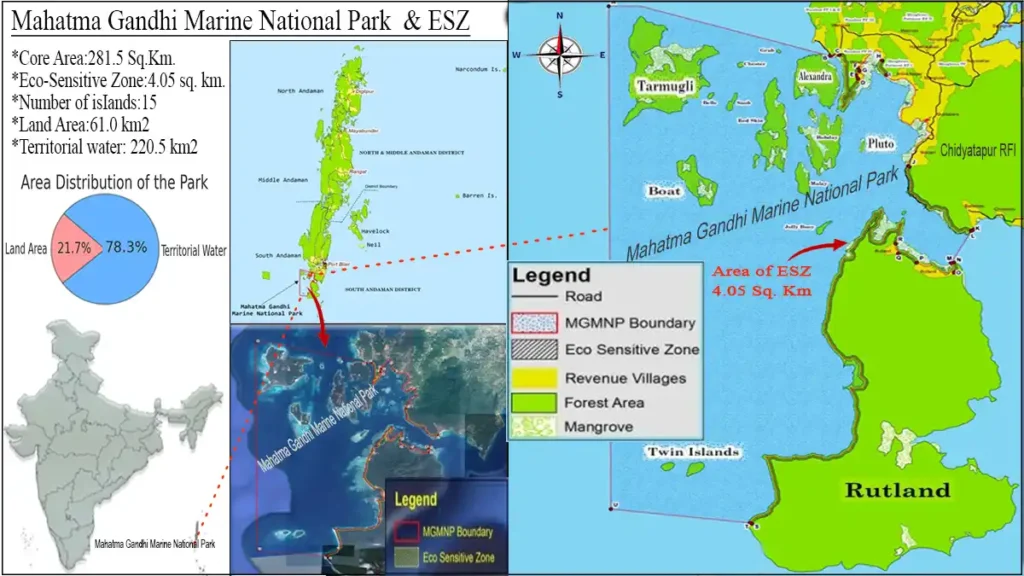
Boundary and Eco-Sensitive Zone (ESZ) of Mahatma Gandhi Marine National Park
The boundary of the Mahatma Gandhi Marine National Park is defined by the Ministry of Environment, Forest, and Climate Change (MoEFCC) in a notification S.O. 2020(E), dated April 28, 2022, under the Environment (Protection) Act, 1986. This national park covers a total area of 281.5 square kilometers, which is a haven for a variety of plants and animals.
- Northern Boundary: Starting near Wandoor village (point “B”), it moves east through Wandoor PF IV block and follows the coast, passing various points until it meets the Mangultan Port Mout RF.
- Eastern Boundary: Beginning at a point “I” in Indranagar, it follows the boundaries of several revenue villages (Indranagar, Manglutan, Guptapara, Manjeri) and meets the coastline at Chidiyatpau RF. It continues through the Mac Pherson Strait to Rutland Island.
- Southern Boundary: From point “S” on Rutland Island, it runs along the southern coastline of the park to point “U” on the southwestern tip.
- Western Boundary: Starting from point “U” near Tarmugli Island, it follows the coastline to point “A” on the northwestern tip of Tarmugli Island and meets the northern boundary at Alexandra Island.
Eco-Sensitive Zone (ESZ): The Eco-Sensitive Zone around the park extends from 0 to 100 meters and covers 4.05 square kilometers.
- Zero extent: In places where the park borders another protected area like Lohabarrack Crocodile Sanctuary (northwest) and some revenue villages, the ESZ has no buffer.
- 100 meters extent: In most areas, the ESZ extends 100 meters into the land and forested areas, providing an important buffer zone to protect the park from human activities such as construction and pollution.
The Geography of Mahatma Gandhi Marine National Park
The geography of Mahatma Gandhi Marine National Park covers a total area of 281.5 square kilometers, but only 61.5 square kilometers is land. This includes 10 large and medium-sized islands (ranging from 1.5 to 23.33 square kilometers) and 5 small islands (around 0.5 square kilometers each), plus about 6 square kilometers of coastal strip above the high tide line. The remaining 220.5 square kilometers consist of open sea and creeks, meaning that land makes up only 21.7% of the park, while territorial waters account for 78.3%.
Floating in beautiful solitude, away from mainland India, in the calm waters of the Bay of Bengal, the park is an archipelago of 15 green and vegetated islands within the Labyrinth group. It is surrounded by emerald waters, coral reefs, isolated rocks, and mangroves, supporting diverse marine ecosystems like tropical evergreen, semi-evergreen deciduous forests, littoral forests, and lush mangroves.
The park also has seagrass beds, but many areas remain unexplored. The known seagrass beds are found between Red Skin Island and Boat Island, in the intertidal areas of Amdera and Wandoor, and the subtidal regions of Chester, Grub, Jolly Buoy, and Tarmugli Islands.
Islands of Mahatma Gandhi Marine National Park with Location and Area
| Sl. | Island | Area (Sq. Km) | Location |
| 1 | Alexandria | 4.97 | 11°34′36″N 92°36′38″E |
| 2 | Jolly Buoy | 1.74 | 11°30′26″N 92°36′41″E |
| 3 | Twins | 1.84 | 11°33′06″N 92°35′10″E (West Twin), 11°33′06″N 92°35′10″E (East Twin) |
| 4 | Belle | 0.08 | 11°34′08″N 92°33′57″E |
| 5 | Malaya | 1.94 | 11°31′48″N 92°36′12″E |
| 6 | Tarmugli | 23.33 | 11°34′30″N 92°33′00″E |
| 7 | Boat | 7.28 | 11°31′35″N 92°33′38″E |
| 8 | Pluto | 0.52 | 11°33′06″N 92°35′10″E |
| 9 | Chester | 0.49 | 11°33′06″N 92°35′10″E |
| 10 | Redskin | 7.07 | 11°33′00″N 92°35′30″E |
| 11 | Grub | 0.47 | 11°33′06″N 92°35′10″E |
| 12 | Rifleman | 0.08 | 11°30′50″N 92°38′40″E |
| 13 | Hobday | 5.28 | 11°32′40″N 92°36′42″E |
| 14 | Snob | 1.45 | 11°35′55″N 92°34′27″E |
| 15 | Rutland | 3.25 (out of 68.23) | 11°33′38″N 92°35′55″E |
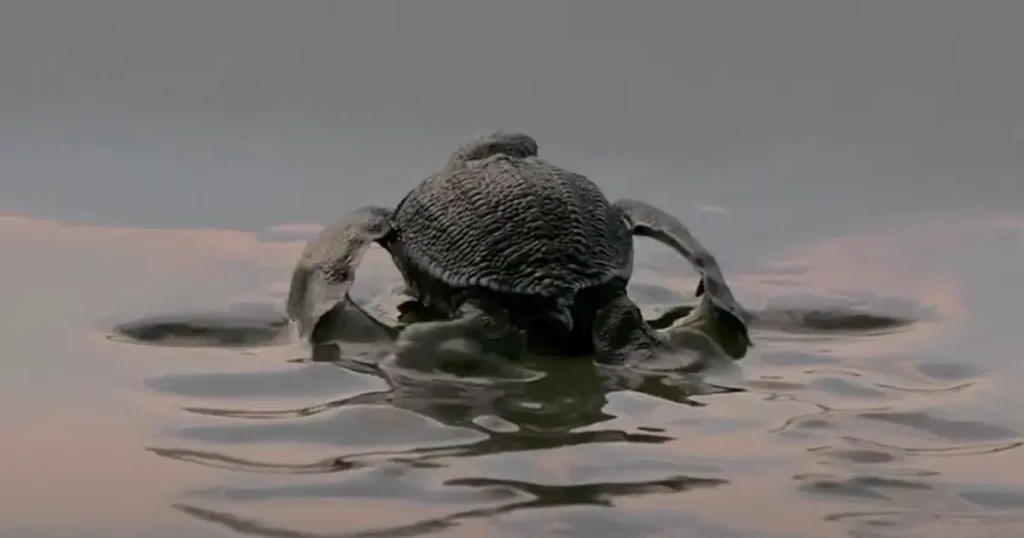
The climate of Mahatma Gandhi Marine National Park
The climate in Mahatma Gandhi Marine National Park is tropical hot and humid climate, which means it’s warm and humid throughout the year. The park experiences two main seasons: the dry season and the monsoon season.
- Dry Season: This typically lasts from November to April. During this time, the weather is pleasant and suitable for visitors. Temperatures can range from 25°C to 32°C (77°F to 90°F), making it comfortable for outdoor activities.
- Monsoon Season: The monsoon usually occurs from May to October, bringing heavy rainfall to the region. This period is essential for the park’s ecosystem as it replenishes water supplies and supports the growth of lush vegetation.
What to See: Biodiversity of Mahatma Gandhi Marine National Park
To enter Mahatma Gandhi Marine National Park, visitors need to pay an entry fee at the Forest Range Office in Wandoor. Authorized tour operators of boats at are available Wandoor Jetty. Since there are limited boats, it’s a good idea to book your tickets in advance from Port Blair.
Photography and diving are allowed only in designated tourist areas after payment of an extra fee. You can explore corals and marine life through glass-bottom boats or by snorkeling. At Jolly Buoy and Redskin Islands, you’ll find resting sheds, changing rooms, and toilet facilities.
During the boat ride to Jolly Buoy or Redskin, you can enjoy beautiful views of mangroves and tropical rainforests. Once you arrive at Jolly Buoy or Redskin, you’ll discover a fascinating underwater world filled with coral reefs, colorful fish, and various marine creatures.
1. Important Turtle Nesting Grounds:
Mahatma Gandhi Marine National Park is an important feeding and breeding ground for sea turtles such as leatherback turtles, olive ridley turtles, green sea turtles, and hawksbill turtles. The beaches of Twin Islands, Boat Island, Tarmugli, and the Jahaji beach of Rutland Island are the main nesting grounds for turtles. They usually breed between October and May.
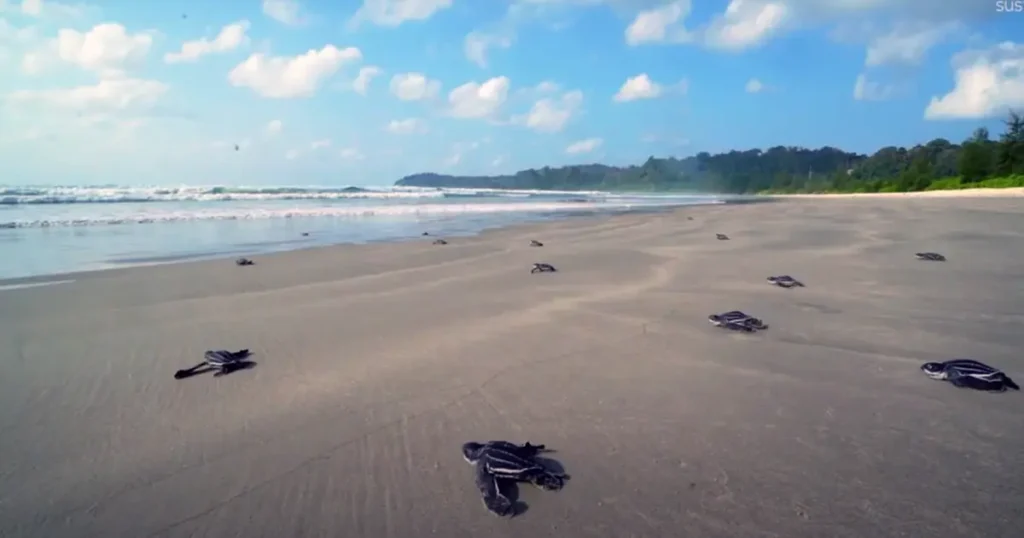
2.Reptiles:
The park has recorded 19 reptile species which include 4 species of turtles, 4 species of lizards, a species of saltwater crocodile, and 10 species of snakes.
The Inland Forest on the islands of Mahatma Gandhi Marine National Park provides habitat for venomous land snakes such as the Andaman cobra (Genus Naja), Andaman cobra king cobra, pit viper, rat snake, wolf snake, and banded krait.
Some rocks in inter-tidal areas, the rocky outcrops, and tree hollows provide hidden places for sea kraits. There are also several sea snakes and non-venomous snakes present on the beaches of the islands in the Marine National Park.
3. Mammals:
The mammal species reported in the park include Andaman wild pig, spotted deer, Andaman masked palm civet, rats, fruit bats, etc. Due to the long geographical isolation of the island, large terrestrial mammals are not well represented in Mahatma Gandhi Marine National Park.
4. Amphibians:
The amphibian species reported in the park are the Paddy frog, Andaman paddy frog of family Ranidae, Indian toad of family Microhylidae, Saltwater frog, and Boulenger’s narrow-mouthed frogs.
5. Diversity of Birds:
Mahatma Gandhi Marine National Park has been recognized as one of the 19 Important Bird Areas (IBA) in the Andaman and Nicobar Islands (IN-AN-11) and has been assigned IBA criteria A1 and A2 by BirdLife International for its restricted-range species and endangered species.
The park has recorded so far about 270 species and sub-species of birds and is designated as one of the endemic bird areas of the world.
The inland forest of Islands within the Park provides a viable habitat and breeding ground for many endangered bird species such as the Andaman teal, Andaman wood pigeon, Andaman dark serpent eagle, White-bellied Sea eagle, brown noddy, parakeets, reef herons, and other avifauna.
Andaman teals, dark brown ducks found primarily in the Andaman and Nicobar Islands breed in the southern portion of Red Skin, South-West of Red Skin Island, South-east of Boat, Tarmugli Island, South Snob Island, and North of Pluto during monsoon (May to June).
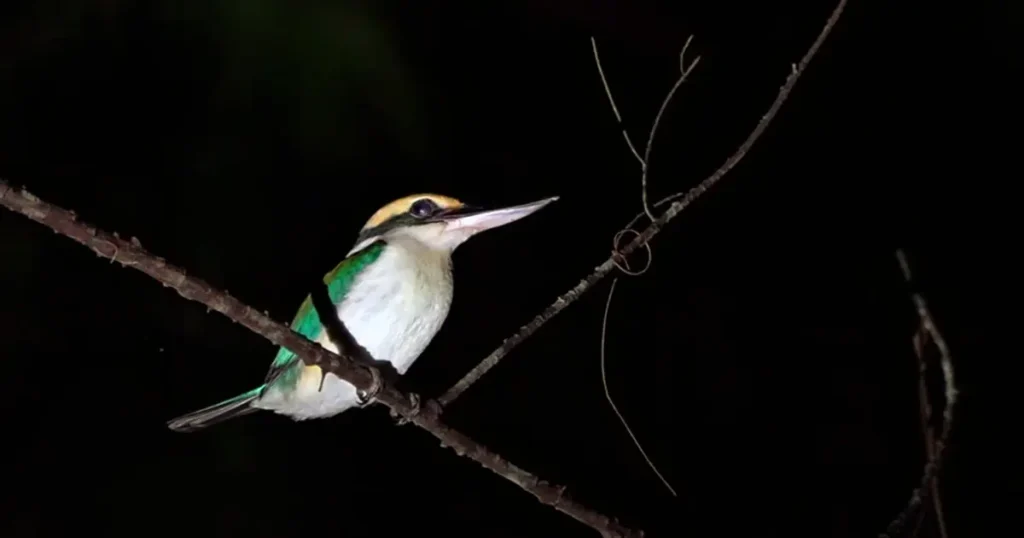
6. Corals:
All islands within Mahatma Gandhi Marine National Park are surrounded by fringing reefs. So far 120 corals species recorded in the park which outnumbers other coral reefs in the country. The majority of corals grow up to a depth of 8 meters in the sea, but they can also grow at depths of up to 40 meters.
Healthy clusters of corals are commonly found in the shallow waters around islands such as Red Skin Island, Grub Island, Tarmugli Island, Jolly Buoy Island, and Boat Island.
Some common coral genera found in the park are Montipora, Fungia, Acropora, Porites, Lobophyllia, and Favia (star coral). These coral reefs serve as vital breeding grounds for nearly all species of fish found in Mahatma Gandhi Marine National Park.
7. Fishes:
More than 282 species of fish, belonging to 42 families, are present in the Marine National Park, which spans diverse coral reefs along the shallow shores of all the islands. The most diverse fish family is Pomacentridae.
Here, one can see large shoals of fish, and hundreds of colorful varieties of coral reef fish while snorkeling. Some of the interesting species present in the park are clownfish, butterflyfish, sharks, stingrays, cleaning wrasse, manta rays, bluefin jack grouper, batfish, various sea anemones, sea urchins, and sea cucumbers.
Other common marine animals are starfish, jellyfish, sea pens, sea fans, sea lilies, feather stars, crabs, octopuses, and giant clams. Sea snakes and saltwater crocodiles are also seen.
Dolphins, sharks, and turtles are common visitors to the park. If lucky, one can even see the critically endangered dugong (known as the sea cow).
8. Flora:
Mahatma Gandhi Marine National Park is very rich in floral diversity, with about 298 spermatophytic taxa (groups of plants that reproduce using seeds) occurring in just 61.5 square kilometers of land. Among these, 18 endemic species are recorded in the area, including gurjan, padauk, Parkinson’s tree, Kurzii devil tree, Crispa, Andaman wild nut, Andaman grape, Andaman garcinia, Puberula, Andaman derris, Wallich’s derris, triangular-leaved Tadehagi, Andaman psychotria, sea mango, diverse-leaved vitex, and Andaman tetrastigma.
Six species of trees are rare and threatened, namely Tadehagi triquetrum (Fabaceae), Bombax insigne, Amoora many, Olax imbricata, Plecospermum andamanicum, and Pittospermum ferrugineum.
The recent discovery of a new wild rice species, Oryza andamanica, from Saddle Peak and the Rutland Island area, highlights that these islands serve as a reservoir of significant biodiversity, much of which remains to be explored.
Four gymnosperms have been reported from the Andaman Islands: Gnetum scandens, Cycas rumphii, Nageia wallichiana, and Podocarpus nerifolius. Their presence in the area adds to the significance of conservation and protection efforts for the National Park.

9.Mangrove Forests:
A considerable area of Mahatma Gandhi Marine National Park is under healthy and intact mangrove forests. The park has recorded 13 species of mangroves namely Scyphiophora apetala, Acanthus ebracteatus, Rhizophora mucranata, Bruguiera gymnorhiza, Xylocarpus moluccensis, Heritiera littoralis, Ceriopstagal, Rhizophora apiculata, Lumnitzera littorea, Xylocarpus granatum, Acanthus ilicifolius, Avicennia officinalis, and Scyphiophora hydrophyllacea.
Among the mangrove species, Genus Rhizophorais is predominantly reported from the Marine National Park.
10. Sea Grass Beds:
There is a presence of seagrass beds in the Mahatma Gandhi Marine National Park but only a few areas have been explored.
The known seagrass beds found in the park are from the area between Boat Islands and Red Skin, the subtidal region of Chester, Grub, Jolly Buoy, and Tarmugli Islands, and the intertidal area of Amdera and Wandoor.
So far, 5 species of seagrasses have been recorded in the park’s territorial water namely Thalassia hemprichi, Cymodocea, Halophilia ovata, Enhalus acoroides, Halodule pinofolia, and Serrulate.
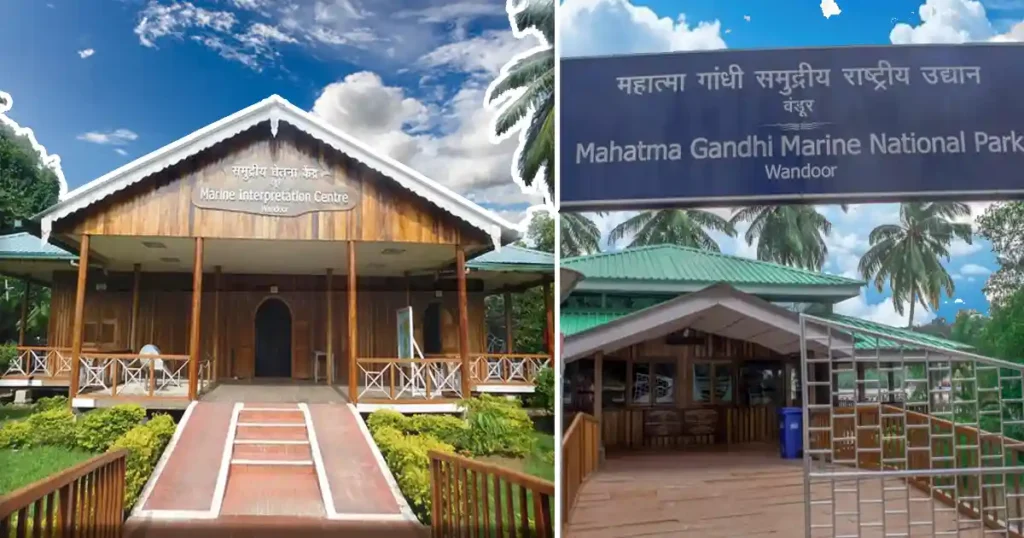
How to get there
The park is reachable by road from Port Blair. Regular state transport, taxis, and private buses ply between Port Blair and Wandoor. Transportation facilities are provided by the Department of Information, Publicity, and Tourism of the Andaman & Nicobar Administration to reach the park. Many private travel agencies offer guided tours to the park from Port Blair.
Where to stay
A private lodge and a Forest Rest House with limited accommodation are situated in Wandoor. However, it is a good idea to stay in Port Blair because various categories of hotels and guest houses are available.
CONCLUSION
Mahatma Gandhi Marine National Park, located in the South Andaman district of the Andaman and Nicobar Islands, is very rich in aquatic biodiversity. It is home to 19 species of reptiles, 19 Important Bird Areas (IBA) in the Andaman and Nicobar Islands, 270 species and subspecies of birds, 120 species of corals, 282 species of fish, 298 spermatophytic taxa of flora, 13 species of mangroves, 5 species of seagrasses, and six species of endangered trees, making it a perfect place for those who want to see marine life.
The newly discovered wild rice species, Oryza andamanica, in the Rutland Island area, highlights the park’s role as a reservoir of significant biodiversity. Additionally, four gymnosperms reported from the Andaman Islands enhance the importance of conservation and protection efforts for the National Park.
The best time to visit Mahatma Gandhi Marine National Park is from November to May.
FAQ
Q: Why is Mahatma Gandhi Marine National Park famous?
A: To explore aquatic biodiversity, Mahatma Gandhi Marine National Park which is located in the South Andaman district of the Andaman and Nicobar Islands in India is a perfect place famous for its rich and varied aquatic habitats.
Q: Which animal is Mahatma Gandhi Marine National Park famous for?
A: Mahatma Gandhi Marine National Park is an important feeding and breeding ground for sea turtles such as leatherback turtles, olive ridley turtles, green sea turtles, and hawksbill turtles.
Q: Which are the 4 marine national parks in India?
A: Mahatma Gandhi Marine National Park, situated in the Andaman Islands; Gahirmatha Marine Wildlife Sanctuary, located in Odisha; Gulf of Mannar Marine National Park, situated in Tamil Nadu; and Malvan Marine Wildlife Sanctuary, located in Maharashtra, are four marine national parks in India.
You May Also Like
- Campbell Bay National Park
- Galathea National Park
- Sikhna Jwhwlao National Park
- Keoladeo National Park
- Desert National Park

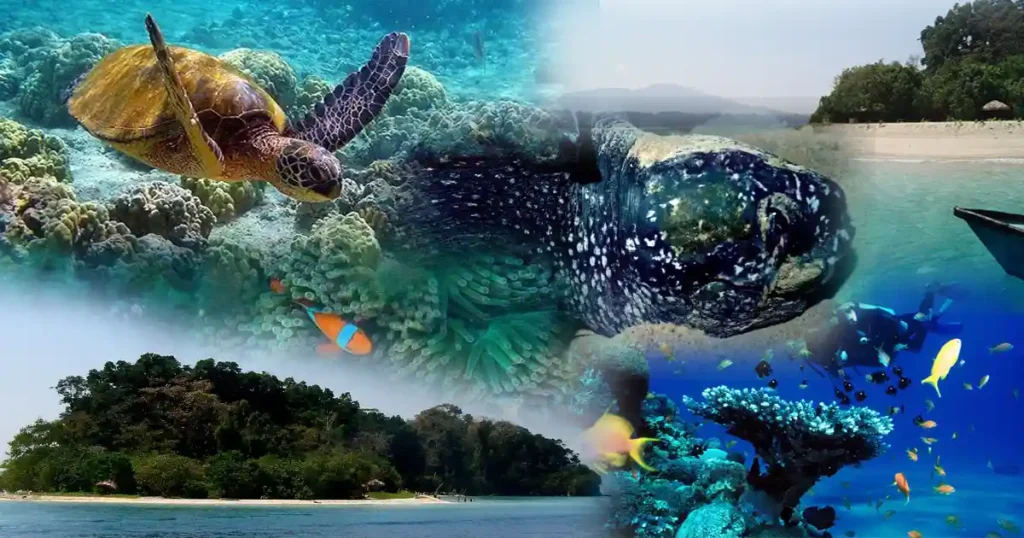


1 thought on “Mahatma Gandhi Marine National Park”